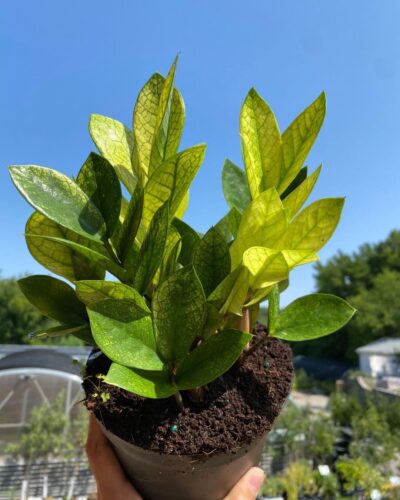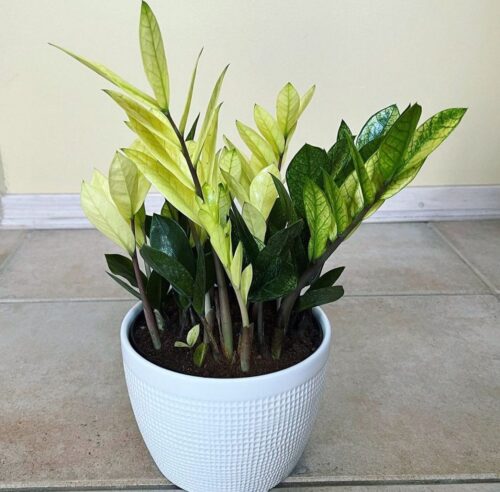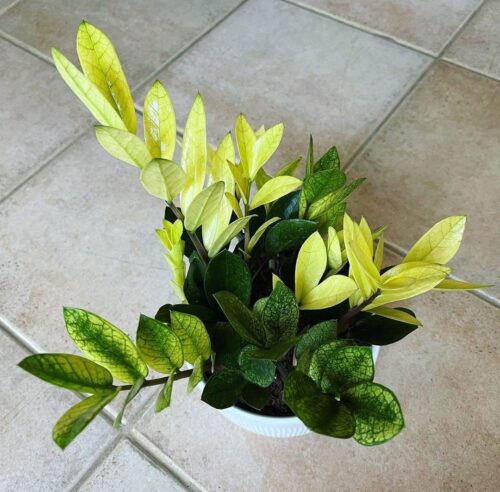Read this Chameleon ZZ Plant Care and Growing Guide with essential tips for creating a green oasis in your indoor garden.
Add a green-yellow hue to your plant collection with this ZZ plant variety. Find more details in the Chameleon ZZ Plant Care and Growing Guide below.
Explore Kalanchoe Millotii Care Guide
Chameleon ZZ Plant Profile

The Chameleon ZZ Plant is a new variety of the classic ZZ plant, from the original all-green ZZ plant. Similar to the introduction of the Raven ZZ plant a few years ago, the Chameleon is a new addition to the ZZ plant family.
Unlike the Raven ZZ, which starts with lime-green leaves that eventually turn almost entirely black, the Chameleon ZZ Plant starts with bright yellow leaves adorned with green veins. As they mature, these leaves transition to a green hue. This distinctive feature gives the Chameleon a unique appearance compared to the standard all-green ZZ plant, although both eventually share a similar green coloration. In favorable conditions, it can reach up to 4 feet tall or more.
The Chameleon variety is under patent protection. Michael Kerry Rimland first discovered it in the month of November 2017 in a garden center in Bangkok, Thailand. Through selective propagation using cuttings in early 2018, it was confirmed that the mutation was stable and could be reliably reproduced in new plants.
Costa Farms, a major plant grower, is now mass-producing the Chameleon ZZ Plant. Consequently, you can expect to encounter this plant in various locations. It’s part of their Trending Tropicals collection, and they currently hold exclusive rights to its production.
Read Jacquemontia Pentanthos Care
Propagating Chameleon ZZ Plant

The Chameleon ZZ Plant is a patented plant variety, which means that it cannot be legally propagated for commercial purposes. However, if you have a ZZ Chameleon plant and would like to divide it for your personal use, you can easily divide the plant at the rhizome level and plant the divisions in separate pots.
Follow Sedum Nussbaumerianum Care Guide
Ideal Growing Conditions for Chameleon ZZ Plant

Light
The Chameleon ZZ Plants grow well with bright, indirect sunlight. Avoid keeping them in direct sunlight, as this can scorch their leaves. Also, direct sunlight can lead to leaf burn and damage. These Plants can adapt to lower light conditions. They can survive in areas with less light, but their growth may slow down, and the coloration of the leaves might not be as vibrant.
Soil
Use well-draining succulent or cactus potting mix as the base soil. Improve drainage by adding perlite (about 1 part perlite to 3 parts potting mix). You can add a small amount of coarse sand. Maintain a slightly acidic to neutral pH level, ideally between 6.0 and 7.0.
Water
Chameleon ZZ Plant has low watering needs, as it can seal moisture in its foliage and potato-like, thick rhizomes. This ability helps this ZZ plant variety to endure extended periods without water, sometimes even shedding its leaves and regrowing them. However, to encourage the growth of new golden-yellow leaves, it’s advisable to water when roughly half of the soil has dried out. If you’re uncertain when to water, it’s generally safer to wait, as ZZ Plants prefer being slightly dry rather than overly wet.
Temperature and humidity
Chameleon ZZ Plant thrives in average room temperatures between 65°F to 75°F (18°C to 24°C). They are comfortable with typical indoor humidity levels, so no special humidity requirements are necessary. Just keep them in a comfortable room, and they should do well.
Check Graptopetalum Paraguayense Care Guide
Chameleon ZZ Plant Care

Fertilize
Fertilize Chameleon ZZ Plants sparingly. Use a balanced, water-soluble fertilizer diluted to half strength during the growing season (spring and summer) every 2-4 weeks. Reduce or eliminate fertilization in the dormant period (fall and winter) when the plant’s growth slows down. Over-fertilization can harm the plant, so go easy on it.
Pruning
Pruning Chameleon ZZ Plants is minimal. Trim away any old or damaged leaves at the base with clean scissors or pruning shears. Regularly remove dead or yellowing foliage to maintain its appearance. Minimal pruning helps the plant focus energy on healthy growth and maintains its tidy appearance.
Repotting
Repotting the Chameleon ZZ Plant should be done every 2-3 years to refresh the soil. Choose a slightly larger pot with drainage holes.
Ensure the rhizome is at the same depth as before and water sparingly after repotting.
Toxicity
Remember that this ZZ Plant variety can be toxic to humans and pets if ingested. They contain calcium oxalate crystals that can cause irritation and discomfort when chewed or swallowed. It’s crucial to keep them out of reach of children and pets and to handle them with care to avoid skin irritation.
Check Philodendron Bloody Mary Care Guide
FAQS
Q: How can I encourage vibrant yellow leaves on my ZZ Plants?
A: To promote new golden-yellow leaves, provide bright, indirect light and water when the soil is about 50% dry. Balanced care encourages colorful foliage.
Q: Is the color of Chameleon ZZ Plant’s leaves a result of chemical treatment or genetic modification?
A: No, the color of the Chameleon ZZ Plant’s leaves is not a result of chemical treatment. It’s a natural characteristic of this plant variety. The leaves naturally emerge in a vibrant yellow color and transition to green as they mature. This color change is due to the plant’s genetics and not external treatments or modifications.
EXPLORE Fireglow Japanese Maple Care Guide



